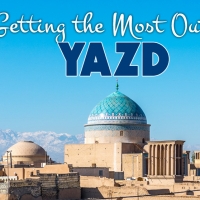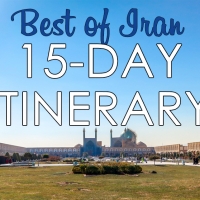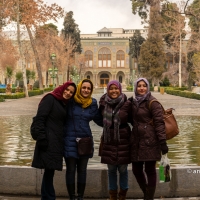- The Middle East Trip: Intro
- Middle East Trip: Arriving in Tehran
- Middle East Trip: Exploring Tehran – Part 1
- Middle East Trip: Exploring Tehran – Part 2
- Middle East Trip: Esfahan – Half of the World
- Middle East Trip: Exploring Esfahan Continues
- Middle East Trip: Our Host in Esfahan
- Middle East Trip: Yazd – The City of Zoroastrianism
- Middle East Trip: A Tour of Persepolis et al
- Middle East Trip: Picnic in Shiraz
- Middle East Trip: Shiraz – Home of Hafez
- Middle East Trip: Back in Tehran
- Middle East Trip: Istanbul – En Route & Arrival
- Middle East Trip: Kind-Hearted Souls in Istanbul
- Middle East Trip: From Amman to Petra, Jordan
- Middle East Trip: CouchSurfing in a Jordanian Cave?
- Middle East Trip: Revisiting the Exquisite Petra
19 December 2011
We arrive in Esfahan just after the call to a morning prayer. I managed to sleep a little bit during the 6-hour long train ride. It was noisy and bumpy, but this was expected as I was too used to the comfort of European trains. But I’m happy that I’m in Esfahan now! I’ve always wanted to go to this city, which is the former capital city of Persia. When I think of Iran, Esfahan is the first thing that comes into my mind. The famous Square is the reason why I am drawn to this place.
On the Quest to Learn the Other Perspectives
As soon as we get off from the train, we go to a prayer room inside the station to perform Fajr prayer and freshen up. After the prayer, Ikmal is approached by a young kid who has been observing him since he started his prayer. The kid asks him, “Sunni?” Ikmal nods, obviously surprised by such question. A small kid is even aware of this! How many kids in Arab countries would know about Shia just by looking at how they pray? I am in disbelief. I understand that Sunnis make up one of the minority groups in Iran (and vice versa in Saudi Arabia, etc), but why do we have to solely focus on our differences rather than what we have in common? Why do we have to make such a clear distinction as if there were two “religions”: Shia and Sunni? What would our scholars say about this? I’ve been asking the same questions over and over again. A lot of them are left unanswered. The more I dig into this topic, the more frustrated and confused I become. I’ve heard many opinions from my counterparts about Shia and I would like to know more about this from the Shia perspectives.
This was the reason why I contacted my CouchSurfing host, Majid (*) in the first place. I came across his profile from CouchSurfing one day and I saw one of his pictures with his wife, wearing a fully covered chador. I had been seeing a lot of CouchSurfing profiles and none of them had any pictures with a chador. So Majid’s profile definitely stood out among others. At that point, I knew that he was religious by Iranian standards and I wouldn’t miss the chance to meet him and his family when I visited Iran. The good news was, he accepted my request to host three of us for two nights. I couldn’t be more delighted when I received his message! I was hosted by Reza (*), who is secular with religious father, met Mansour (*) and his friend who associate religion with the government that they dislike, and Saeede who is moderately religious. Majid is probably different compared to any of those CSers that I met in Tehran, so I’m hoping that I will be able to get a different view of Iran from him.
Meeting our CouchSurfer
The moment we get out of the Esfahan train station, we are greeted by some taxi drivers who can barely speak English. Communication is a big problem even though I have Majid’s full address in hand. I call Majid to sort this out; he talks to the driver for direction, tells me how much exactly we are expected to pay for the taxi, and 30 minutes later, we are in front of his house’s door at around 6.30 am. It’s still very early in the morning, but Majid welcomes us with a smile. Knowing that this family is religious, I try my best to be more careful with how I act so that I will not offend them in any way. To be safe, I don’t offer my hand to shake when I first meet Majid. Reza hinted about this yesterday as he was surprised to find out that I would shake hands with the opposite sex, although I wore a headscarf. He told me that religious Iranians would never do this. Reza was correct. I find out that Majid only shakes hands with Ikmal and says hello to Nabilah and me.
 Majid’s house is perfect for a couple who does not have kids (yet). The size is just right. It consists of a big living room with a signature Iranian carpet, a small kitchen with a big samavar, one bedroom, and a storage/study room in the basement. The shower is inside the house, while the toilet is outside of the house. While we are getting ready for yet another sightseeing around the city, Majid spreads out a white cloth on the floor of his living room. He then brings some pieces of bread and jams from the kitchen. We are not expecting breakfast at his house at all, so this is a bit of a surprise. What makes me, even more surprise is that the husband, not the wife, is preparing for the breakfast :). That’s something that Indonesian men don’t do, isn’t it? Hehehe. As soon as we finish moving the foods from the kitchen, his wife finally appears, wearing a white patterned chador. Her name is Zahra (*).
Majid’s house is perfect for a couple who does not have kids (yet). The size is just right. It consists of a big living room with a signature Iranian carpet, a small kitchen with a big samavar, one bedroom, and a storage/study room in the basement. The shower is inside the house, while the toilet is outside of the house. While we are getting ready for yet another sightseeing around the city, Majid spreads out a white cloth on the floor of his living room. He then brings some pieces of bread and jams from the kitchen. We are not expecting breakfast at his house at all, so this is a bit of a surprise. What makes me, even more surprise is that the husband, not the wife, is preparing for the breakfast :). That’s something that Indonesian men don’t do, isn’t it? Hehehe. As soon as we finish moving the foods from the kitchen, his wife finally appears, wearing a white patterned chador. Her name is Zahra (*).
 It is during the breakfast (on the floor) that we are able to finally sit down and talk to Majid and Zahra at great length. I am surprised to find out that Majid is about the same age as me. Due to his quiet & calm characters, he looks a bit older than I thought. Zahra, on the other hand, is about two years younger than me. She has a university degree in the tafsir Qur’an but prefers to become a housewife for now. She can speak a little bit of English; occasionally asking Majid to translate when she does not understand our conversation. We also find out that we are the first Muslim travellers that they host. They have hosted quite a number of non-Muslims from different countries before. Majid is aware that many Iranian CouchSurfers are different than his; this is the reason why he wants to host foreigners. He wants others to learn about a different face of Iran as well as his religion. I tell him that we are very curious about Shi’ism and have many questions that we would like to ask to him later on. We agree to start the conversation after dinner time today.
It is during the breakfast (on the floor) that we are able to finally sit down and talk to Majid and Zahra at great length. I am surprised to find out that Majid is about the same age as me. Due to his quiet & calm characters, he looks a bit older than I thought. Zahra, on the other hand, is about two years younger than me. She has a university degree in the tafsir Qur’an but prefers to become a housewife for now. She can speak a little bit of English; occasionally asking Majid to translate when she does not understand our conversation. We also find out that we are the first Muslim travellers that they host. They have hosted quite a number of non-Muslims from different countries before. Majid is aware that many Iranian CouchSurfers are different than his; this is the reason why he wants to host foreigners. He wants others to learn about a different face of Iran as well as his religion. I tell him that we are very curious about Shi’ism and have many questions that we would like to ask to him later on. We agree to start the conversation after dinner time today.
Naqsh-e Jahan Square
After breakfast, Majid lends us a map of Esfahan and provides us with some tips on where to go and visit. He suggests us to visit the Square and spends the entire day over there. As the house is centrally located, it only takes a few minutes by bus to reach the Imam Square (Naqsh-e Jahan Square). The traffic in Esfahan is not as bad as the one in Tehran. It seems to have more space and fewer people. It is also less chaotic, even though we are still struggling when it comes to crossing the streets here. At the first glance, the Imam Square doesn’t look impressive from the outside. It is only when I pass the narrow alley of the bazaar to enter the square itself that I realise how HUGE and magnificent this place is. The Imam Square is a UNESCO World Heritage Site with an area of 89,600 m2. Surrounding the square is the Imperial Bazar along with the three iconic buildings of the Safavid era, built during the rule of Shah Abbas I. The Shah is the one who ordered the move of the capital city of the Persian Empire from Qazvin to Esfahan in 1598. The construction of the square and its landmarks was ordered to signify the power and wealth of Persian Empire.
I can’t believe that I am standing here, in the city known as half of the world (nesf-e jahan). It is such a beautiful and special place to start the day. The sky is blue. The sun lights up the whole Square. Merchants are bringing goods. Shopkeepers start to open their shops. People are rushing to run a few errands. I can’t stop admiring this great square. On my right is the Ali Qapu Palace, which was used by the Shah for the reception of the noble visitors and foreign envoys. On my left is the mosque that has only one big dome with no minarets, called Sheikh Lutfallah Mosque. This mosque was meant for the royal family, hence it is of a smaller size. The Imam Mosque, located between Ali Qapu Palace and Sheikh Lotf Allah Mosque, is the main masterpiece of the Square. With its large shiny blue dome (the largest one in the city!) and four minarets, the mosque has called for prayer since the year 1629. The two mosques and the palace are connected by the Imperial Bazaar, which keeps the city alive. The bazaar surrounds and encloses the square.
(Unfortunately, I am not a good photographer, so I didn’t take photos that do justice to the square. Here is the picture of the square from Wikipedia. R-L: Ali Qapu Palace, Imam Mosque, and Sheikh Lotf Allah Mosque. I stood in the exact same spot and this is exactly what I saw)
 As we walk to the south of the square towards the direction of the Imam Mosque, we occasionally stop by to check out some shops in the bazaar. There are not many people in the square, but we look so different that we eventually become the centre of attention. Friendly strangers ask us where we are from and whether Iran is beautiful or not. Those who don’t dare to ask would rather smile at us instead. I am getting more comfortable with being the centre of attention. At least, I don’t feel freak out anymore. I take the liberty to try to start conversing with anyone, but all I get is shrugs or. I really need to learn Persian!
As we walk to the south of the square towards the direction of the Imam Mosque, we occasionally stop by to check out some shops in the bazaar. There are not many people in the square, but we look so different that we eventually become the centre of attention. Friendly strangers ask us where we are from and whether Iran is beautiful or not. Those who don’t dare to ask would rather smile at us instead. I am getting more comfortable with being the centre of attention. At least, I don’t feel freak out anymore. I take the liberty to try to start conversing with anyone, but all I get is shrugs or. I really need to learn Persian!
Imam Mosque
Arriving at the entrance of the Imam Mosque, we are stopped by an Iranian man who is telling us to pay the ticket before entering the mosque. Really?! Do I really have to pay before entering a mosque? What if I want to pray?! Maybe he does not know that we are Muslims. Or maybe that’s just the rule that tourists have to follow. Anyway, I sigh at the fact that the mosque is being renovated. While the two minarets and the details of the facade are indeed magnificent, the renovation bothers me somehow. I love the combination of turquoise and gold/yellowish colour of the mosaic tiles — a distinguished feature of Iranian mosques. We enter the mosque (with our shoes) through a small door which takes us to a long hallway with its ceiling covered with tiles.
At the end of the hallway, we reach the main courtyard and end up seeing this amaaaaaazing masterpiece that blows me away:

 With two tall minarets, the east iwan (gateway) is just too huge! I take a picture of some people walking so that you can see how big this beautiful structure is. Subhanallah. I’ve never seen anything like this before. The iwan is completely covered with tiles, which contain some giant inscription in Arabic; perhaps a Qur’anic verse or some sorts. I love the colour of minarets’ tiles. Its blue colour is lighter and softer than the iwan itself.
With two tall minarets, the east iwan (gateway) is just too huge! I take a picture of some people walking so that you can see how big this beautiful structure is. Subhanallah. I’ve never seen anything like this before. The iwan is completely covered with tiles, which contain some giant inscription in Arabic; perhaps a Qur’anic verse or some sorts. I love the colour of minarets’ tiles. Its blue colour is lighter and softer than the iwan itself.
We continue on walking towards the east iwan, where the largest dome in the city is located. Standing in the middle of the dome, our voice echoes the whole building. A young Iranian woman approaches us and asks us where we are from. It turns out she studies in Malaysia! What a coincidence. Her parents can speak English too and they manage to explain to us the Arabic inscription on the ceiling of the dome, which is actually one of the verses in the Qur’an. I just love talking to strangers!
Time passes by so quickly. We realise that we spend too much time in the mosque. We really need to get going!
(*) Names are NOT real.




3 Responses
reading my blog and found your comment from couple years ago…
so here i am re-visiting your blog… d-:
great travel and nice pictures… (-;
Amel,… aku irii. ingin ke Isfahan juga.. 🙂
hey there.
remember me? oh, I truly remember you guys! these days are the days we had some nice experiences together ! in memory of those days im just reading your stories and feeling like wish you were here to spend another afternoon drinking Chai! Iran is so different these days. people are so sad and we’re not hoping a good future. :(( everything is just messed up with people’s feelings. Pray for us. hope to see you again Amalia. send my best regards to Foogie. really miss you!
Mohammad/ the guy in Imam mosque